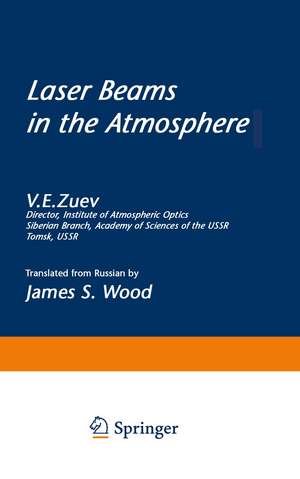Laser Beams in the Atmosphere
Autor V. E. Zueven Limba Engleză Paperback – 15 noi 2012
Preț: 651.34 lei
Preț vechi: 766.28 lei
-15% Nou
Puncte Express: 977
Preț estimativ în valută:
124.65€ • 129.66$ • 102.91£
124.65€ • 129.66$ • 102.91£
Carte tipărită la comandă
Livrare economică 15-29 aprilie
Preluare comenzi: 021 569.72.76
Specificații
ISBN-13: 9781468488838
ISBN-10: 146848883X
Pagini: 520
Ilustrații: 516 p. 110 illus.
Dimensiuni: 155 x 235 x 27 mm
Greutate: 0.72 kg
Ediția:1982
Editura: Springer Us
Colecția Springer
Locul publicării:New York, NY, United States
ISBN-10: 146848883X
Pagini: 520
Ilustrații: 516 p. 110 illus.
Dimensiuni: 155 x 235 x 27 mm
Greutate: 0.72 kg
Ediția:1982
Editura: Springer Us
Colecția Springer
Locul publicării:New York, NY, United States
Public țintă
ResearchDescriere
Although scarcely 20 years have passed since the creation of the first laser, laser engineering has enjoyed a variety of applications in science and in practice. Among these applications, a special pI ace is held by those related to the propagation of laser radiation in the atmosphere. Some, such as laser communication and information-transmission systems, locating and teleme tering systems, and mapping and navigation systems, require access to quantitative data on the effects of the atmosphere on the parameters of the laser beam serving as the carrier of useful information, since the efficacy of any such system depends significantly on the influence of the atmosphere. Another set of laser applications associated with the propagation of coherent radiation in the atmosphere requires the solution of both direct and inverse problems related to this complex subject. The kind of applica tion in question is the use of lasers for long-range monitoring of various physical parameters of the atmosphere-a new and highly promising direc tion in science and engineering.
Cuprins
1. Refraction of Light Rays in the Atmosphere.- 1.0. Introduction.- 1.1. Slant-Path Terrestrial Refraction.- 1.2. Horizontal-Path Terrestrial Refraction.- 1.3. Random Refraction.- 1.4. Spectral Behavior of Optical Refraction.- 1.5. Influence of the Error of Determination of Various Parameters on the Error of Calculation of the Terrestrial Refraction Angles.- 1.6. Experimental Studies of Geodesic Refraction.- 1.7. Conclusion.- 2. Absorption of Laser Radiation by Atmospheric Gases.- 2.0. Introduction.- 2.1. Fundamental Definitions.- 2.2. Absorption at an Individual Line.- 2.3. Shape of the Far Wings.- 2.4. Origin of the Absorption Spectra of Atmospheric Gases.- 2.5. General Description of the Absorption Spectra of Atmospheric Gases.- 2.6. Methods of Calculation of the Line Parameters and Absorption Coefficients of Atmospheric Gas Molecules.- 2.7. Experimental Methods for Determination of the Absorption Coefficients.- 2.8. Tables of Parameters of the Spectral Lines of Atmospheric Gases.- 2.9. Absorption Functions for Laser Sources.- 2.10. Slant-Path Absorption of Laser Radiation in the Atmosphere.- 2.11. Limits of Applicability of Bouguer’s Law.- 3. Scattering of Laser Radiation in the Atmosphere.- 3.0. Introduction.- 3.1. Molecular Scattering.- 3.2. Scattering by a Single Particle.- 3.3. Scattering by a System of Particles.- 3.4. The Scattering Matrix.- 3.5. Scattering by Clouds and Fogs.- 3.6. Scattering by Hazes.- 3.7. Scattering by Precipitations.- 3.8. Angular Scattering Functions of Polydisperse Aerosols.- 3.9. Luminance of Forward- and Backscattered Radiation.- 3.10. Limits of Applicability of Bouguer’s Law.- 3.11. Polarization Characteristics of Scattered Laser Radiation.- 3.12. Transient Scattering.- 3.13. Intensity Fluctuations of Spatially Confined Beams in Scattering Media.- 3.14. Optical Models of Atmospheric Aerosols.- 4. Propagation of Laser Radiation in a Turbulent Atmosphere.- 4.0. Introduction.- 4.1. General.- 4.2. Turbulence Broadening of a Laser Beam in the Atmosphere.- 4.3. Distortion of Coherence of the Field of a Laser Beam in a Turbulent Atmosphere.- 4.4. Random Wander of Laser Beams in a Turbulent Atmosphere.- 4.5. Intensity Fluctuations of Laser Radiation in a Turbulent Atmosphere.- 4.6. Distribution Function of Intensity Fluctuations.- 4.7. Random Spatial Intensity Peaks.- 4.8. Averaging Effect of the Receiving Aperture.- 4.9. Phase Fluctuations in Laser Beams.- 4.10. Correction for Turbulent Distortions of Laser Beams.- 4.11. Conclusion.- 5. Nonlinear Effects Associated with the Propagation of Laser Radiation in the Atmosphere.- 5.0. Introduction.- 5.1. Optical Breakdown of Gases.- 5.2. Nonlinear Spectroscopic Effects in Gas Media.- 5.3. Thermalization of a Molecular Gas in Resonance Excitation by Laser Radiation.- 5.4. Self-Induced Thermal Effects of Laser Beams.- 5.5. Self-Induced Thermal Effects of Laser Beams in Atmospheric Aerosols.- 5.6. Propagation of Laser Radiation in Nonlinear Randomly Inhomogeneous Media.- 5.7. Self-Focusing of Laser Radiation Due to the Kerr and Electrostriction Effects.- 5.8. Effects of Stimulated Scattering of Strong Radiation in the Atmosphere.- 5.9. Conclusion.- 6. Optical Background Noise in the Atmosphere.- 6.0. Introduction.- 6.1. General Description of Optical Background Noise in the Atmosphere.- 6.2. Background of Scattered Solar Radiation.- 6.3. Self-Radiation Background of the Atmosphere.- 6.4. Characteristics of the Outgoing Radiation of the Earth-Atmosphere System.- 6.5. Characteristics of the Reflection of Optical Radiation by the Underlying Surface.- 6.6. Conclusion.- 7. Laser Applications in Atmospheric Research.- 7.0. Introduction.- 7.1. Fundamentals of Methods for Laser Probing of the Atmosphere; the Lidar Equation.- 7.2. Quantitative Interpretation of the Lidar Equation.- 7.3. Separation of the Aerosol and Molecular Components of Echo Signals.- 7.4. Investigations of the Lidar Ratio.- 7.5. Influence of Multiple-Scattering Effects on Probing Results.- 7.6. Inverse Problems of Laser Probing of Atmospheric Aerosols.- 7.7. Laser Probing of Clouds.- 7.8. Laser Monitoring of Industrial Aerosols.- 7.9. Laser Monitoring of Aerosols in the Troposphere and Stratosphere.- 7.10. Determination of the Slant-Path Transmittance of the Atmosphere.- 7.11. Laser Monitoring of Humidity and the Concentration of Gaseous Components of the Atmosphere.- 7.12. Laser Monitoring of the Temperature, Density, and Pressure.- 7.13. Laser Methods for the Determination of Wind Velocity.- 7.14. Laser Determination of the Turbulence Characteristics of the Atmosphere.- 7.15. Laser Probing of the Atmosphere from Space.- 7.16. Determination of the Concentrations of Atmospheric Gases by Laser-Spectroscopic Methods.- 7.17. The Outlook for Future Research and Development.- References.
























